The first two images I saw of Japan as a young child were of Himeji Castle surrounded by cherry blossom and a Geisha standing on a small bridge. They awakened my fascination with the country, its history and its culture. From our first visit that fascination has continued to grow and I’ve returned at every opportunity. Across the country, we’ve discovered temples, castles, gardens and shrines that are hundreds of years old, some over a thousand years old but my first visit to this World Heritage site I will never forget.
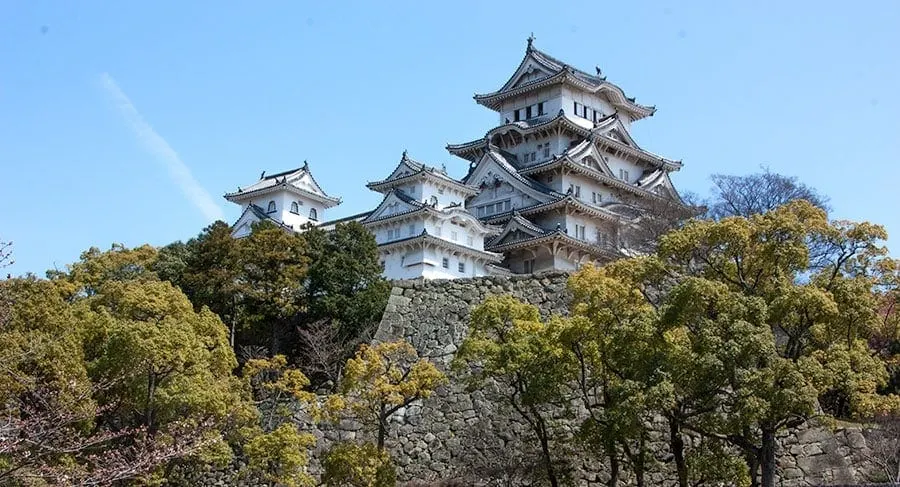

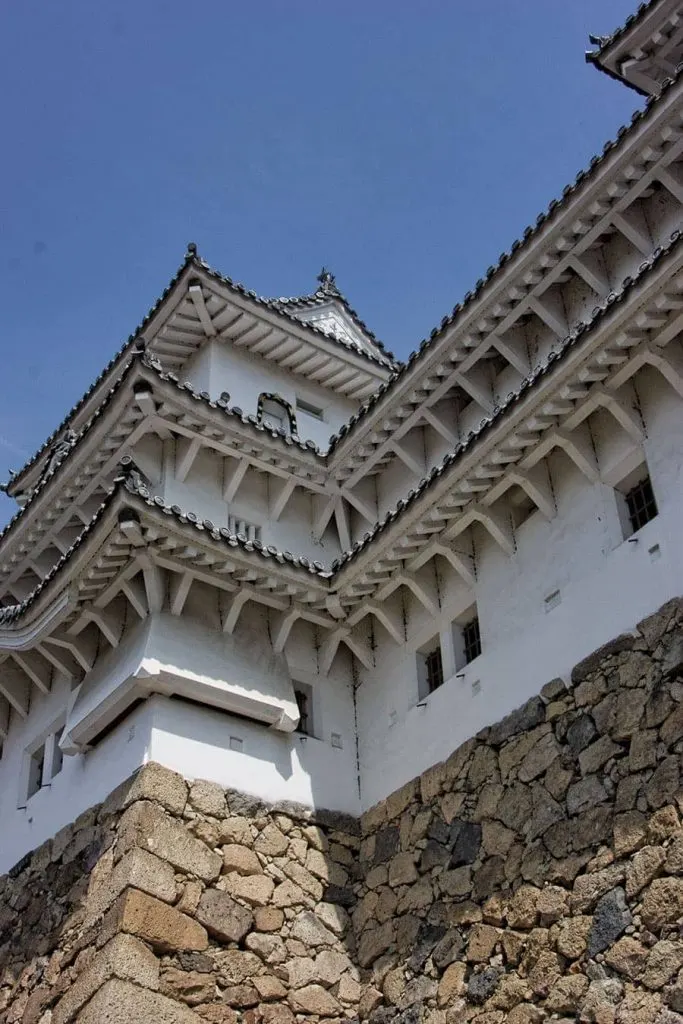
Getting to Himeji Castle
Most visitors to Himeji castle will make their way from the major cities in the nearby Kansai area; Kyoto, Osaka or Kobe. We travelled from Kyoto for the day which only took 45 minutes thanks to the technological wonders of the Japanese bullet trains and the cost savings of the JR Pass which had already more than paid for itself. If you don’t have the JR pass you might choose a slightly slower local train at a substantial cost saving.
As you exit the station you follow the main road, and likely a steady stream of people directly to the castle. It’s a flat and easy 10-15 minute walk but there is a loop bus you can use if you need it.
There’s no way to miss the stunning castle looming up in front of you and on the day we visited this beautiful bride was being photographed in her traditional wedding kimono.
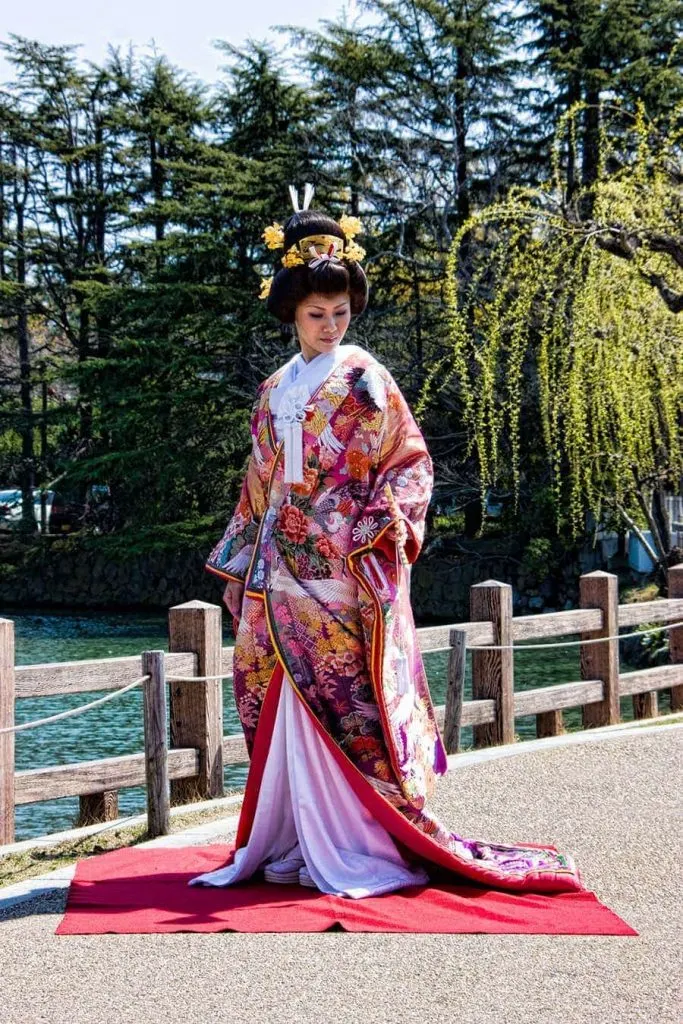
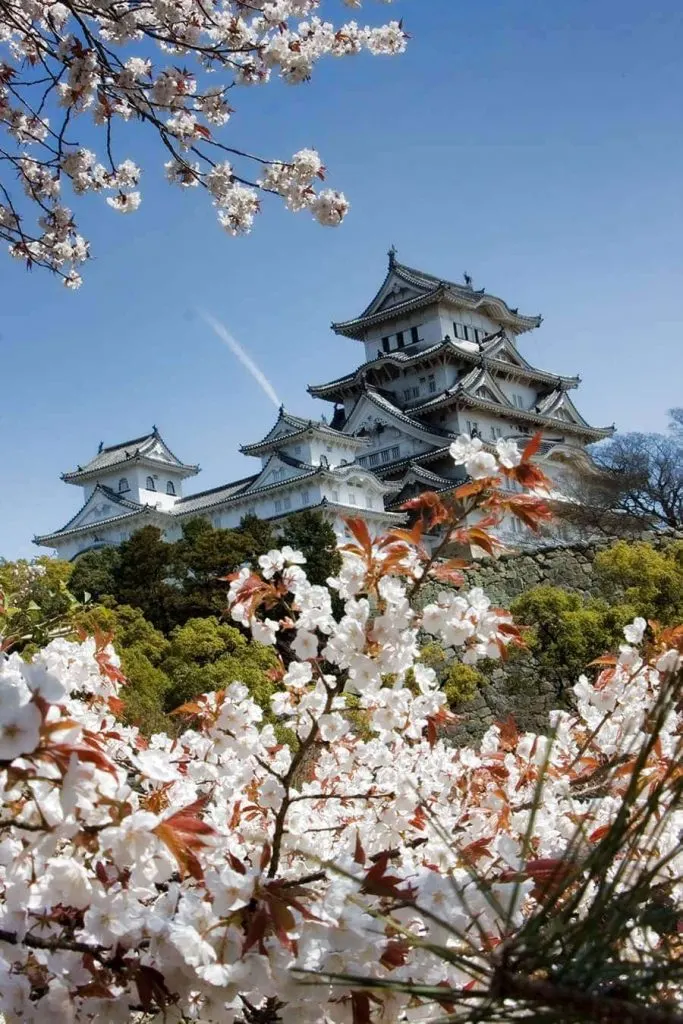
The Castles History
The origin of the castle dates back to 1333 when a fort was constructed on the site by Norimura Akamatsu who ruled the Himeji district at that time. The fort was converted into a three-story castle with over 30 turrets in 1581 by Hideyoshi Toyotomi after Emperor Nobunaga Oda took control of the area in 1577. Then in 1601 when Toyotomi was defeated by Ieyasu Tokugawa in the battle of Sekigahara, control of the castle was passed to Ikeda Terumasa in recognition of his support. Ieyasu spent nine years constructing additions to the castle which resulted in its current form with the 5 story tenshu and triple moat.
Subsequently, several other families inherited and occupied the castle including the Honda, Okudaira, Matsudaira, Sakakibara and Sakai families. The castle was occupied until 1871 when it was abandoned during the Meiji period. At that time many castles were destroyed to mark the end of the feudal period but Himeji survived with only a few gates and corridors dismantled to make way for military barracks. The castle was then sold and the new owner was intent on demolishing it for development but the costs were too high. The castle also survived a bomb that failed to explode on impact during WWII and more recently the great Hanshin earthquake of 1995.
Himeji Castles Design
Himeji castle is recognised as one of Japans top three castles and arguably the most well known and best-preserved. It’s known as the white heron castle for its elegant design and because its wooden walls are completely covered with white plaster. The plaster makes it more fire-resistant, a major consideration when considering how many of Japans castles have been lost to fire over the years. You can see the plaster in this photo, not only on the castle itself but on all the surrounding corridors and walls.
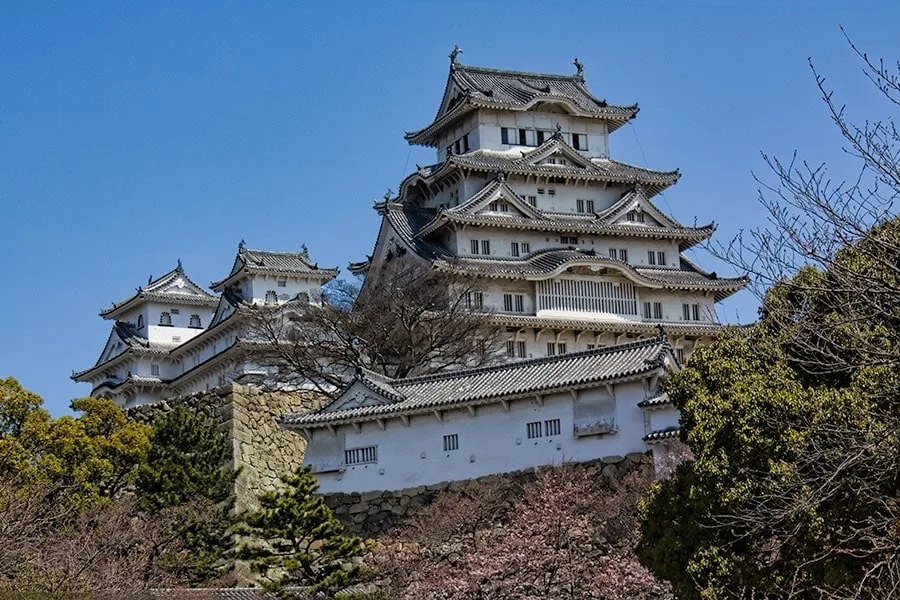
Himeji-jo is a hirayamajiro, or a flatland-mountain castle built to take advantage of both the elevation of the hill it’s built on and the visibility across the plains surrounding it. Its design includes many of the most advanced features of the time specifically for defense under heavy attack but the castle was never actually used in a battle.
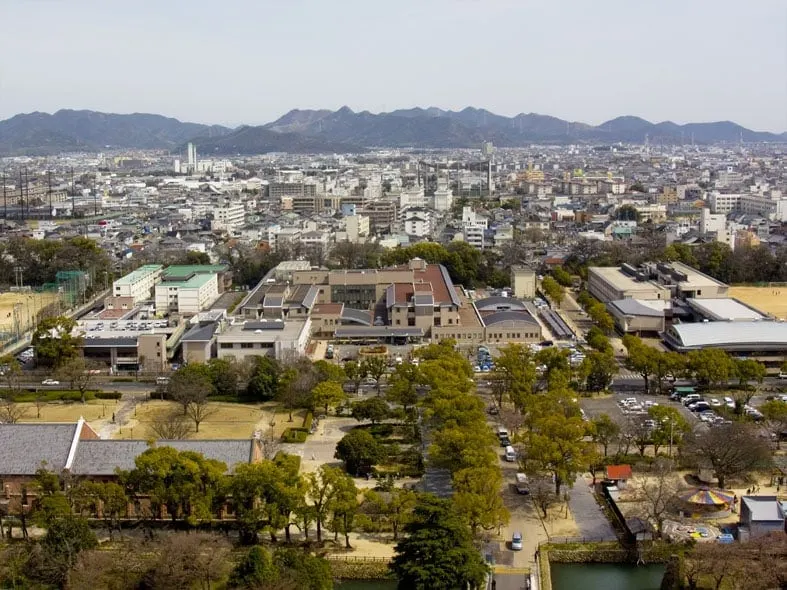
One of the parts of the castle you can go inside is the Hyakken-roka (long corridor) which is a 300 metre long building surrounding the lords mansion located in the Nishino-maru Bailey. You can enter rooms off the corridor which would have been the rooms for the maids who served Sen Hime (Princess Sen). It was exceptionally busy on the day this photos was taken, it was cherry blossom season and only days before the castle was due to begin it’s recent renovations, the crowd did thin out a bit as we wandered through so maybe we just entered with a bus tour.
As you wander through you can see the various defense mechanisms including shoots out the side of the corridor where missiles, boiling water or even oil could be poured on enemies trying to gain access. The steep fan shaped stone walls would have been almost impossible to scale and well designed for defending from the top.
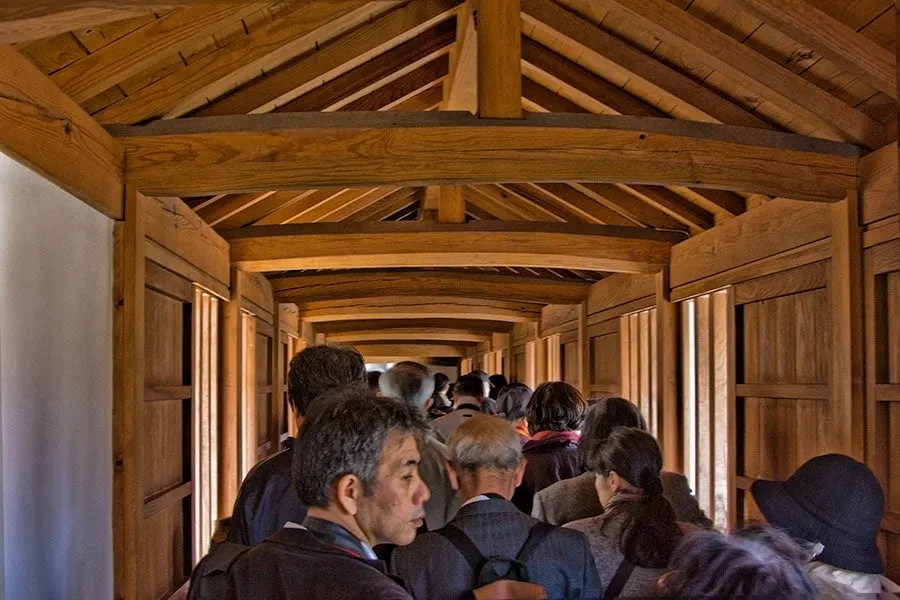
In the main castle many design features have been preserved and the wooden floors and pillars polished smooth from centuries of socks. There are also a few museum displays but it’s mostly left empty giving a good feel of both its scale and beauty. One thing that surprises me with Japanese castles is how steep and tall the interior stairs are. I really need to stretch to step up and although I’m not tall, on average we are taller than our ancestors back then so it must have really been a climb.
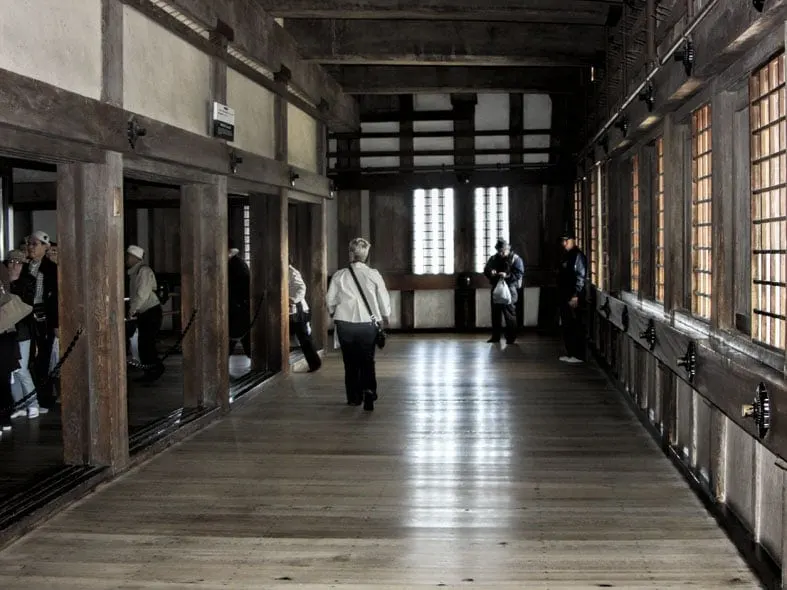
As you walk around outside you will notice the round end tiles on the roof and how they have different crests (called Kamon in Japan), although the overall design of the castle hasn’t changed since the early 1600s these crests represent the family line who last modified or maintained that section of the castle.
Himeji castle was made a UNESCO World Heritage Site in 1993 and 5 individual structures within the complex are designated National Treasures. The castle has recently come out of a major restoration period designed to ensure it’s protected for future generations. After being completely covered with a tent-like structure for several years while the work continued behind the veil it will officially be complete at the end of March 2015. It’s great to have it displayed in all it’s beauty again.
Himeji was the first castle we visited in Japan, it really is an impressive sight and I’d definitely go back at least to explore the gardens when I’m in that area again. Although some might say you only need to see one Japanese castle to have seen them all I don’t agree, I’ve been to around 10 now I think and while I have enjoyed some more than others they have pretty much all had something special about them.
Visitor Information
- Himeji Castle is open 9 am to 5 pm and until 6 pm through the summer months. It’s only closed two days a year on the 29th and 30th December.
- Entry fees is now 1000 Yen, increased in 2016 to recoup some of the substantial cost of the recently completed 5-year renovation programme.
- The castle is a 15-minute walk, or 5-minute bus ride, from Himeji station.
- The most up-to-date information can be found on the official site, I’ve linked the English language page here.
If you’ve visited Himeji Castle I’d love to know your thoughts in the comment below. Is Himeji a location you’d consider visiting on a trip to Japan?
Lesley Peterson
Monday 30th of March 2015
Absolutely stunning photos! How great Himeji has undergone a restoration and is receiving UNESCO world heritage site status. Getting to Japan and visiting Himeji Castle would be a dream come true.
Josh
Tuesday 24th of March 2015
Beautiful photos and great info for when we visit Japan. Looks amazing and can not wait to visit.
Andrea
Sunday 22nd of March 2015
This UNESCO World Heritage site is breathtakingly beautiful. I love the architecture and surrounding landscape. I could imagine spending an afternoon strolling through the grounds (and love that you included how to get there)!
Jennifer
Sunday 22nd of March 2015
Great post and such a beautiful place. I know what you mean about hating history in school and now rediscovering a joy of learning about it when you actually travel to a place - I feel exactly the same way.
Dana
Sunday 22nd of March 2015
It is stunning! The castle has had an interesting history. It's amazing that it managed to survive attacks, a bomb and earthquake.